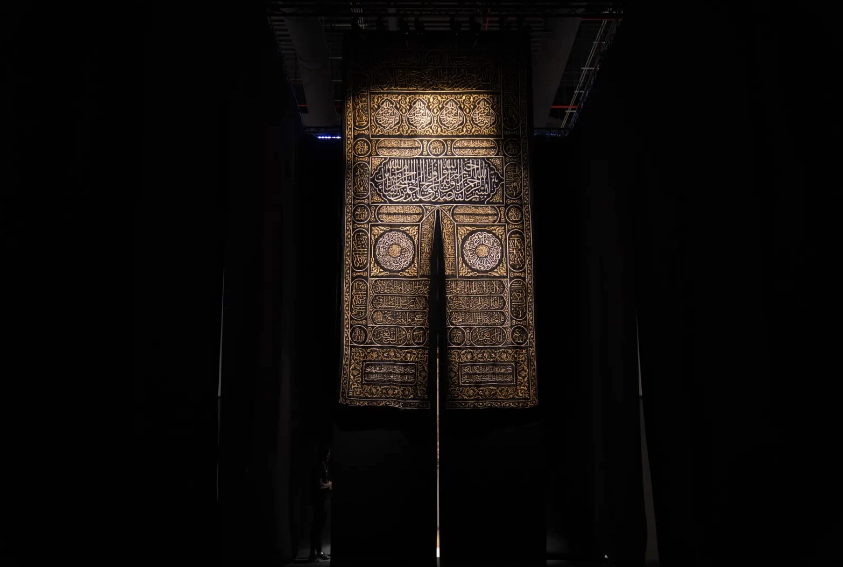Articles
In Saudi Arabia, in the footsteps of the Prophet
Article author: Inés Eléxpuru - FUNCI
Date of publication of the article: 28/03/2023
Year of publication: 2023
Article theme: Archaeology, Architecture, Art, Corán, Exhibitions, History, Inmigration, Islam.
Hijrah: in the footsteps of the Prophet. This was the theme chosen by Ithra (the King Abdulaziz Centre for World Culture) to explore, in different exhibiting and audiovisual formats, the Hegira, or exile to the city of Medina that the Prophet Muhamad undertook with his companions and family, fleeing persecution and repression. A sadly topical issue, and at the same time deeply rooted in Islamic culture. A milestone in the history of Islam and a profound cause for reflection, especially suitable for the month of Ramadan, when Muslims strive for spiritual and physical purification.
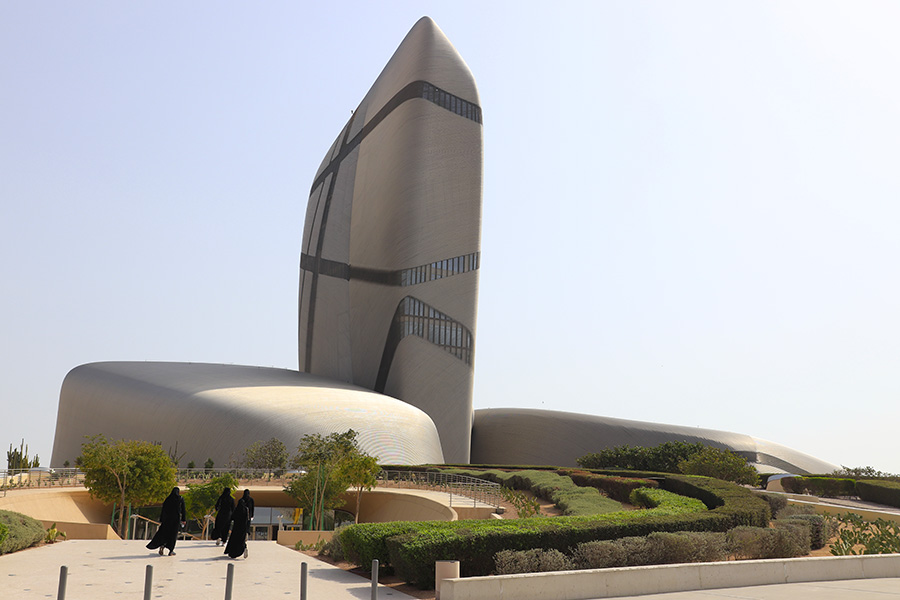
FUNCI, represented by Encarna Gutiérrez, Secretary General, and Inés Eléxpuru, Director of Communications, had the pleasure of participating in a trip organised by Ithra (which in Arabic means ‘enrichment’) to different parts of Saudi Arabia from 6 to 10 March, for an interesting and novel incursion into this subject. A contact with the local culture, which at the same time is universal, given the undeniable historical burden that this country, and especially the holy places, holds for the more than 1.5 billion Muslims around the world: Mecca and Medina.
In addition to the FUNCI representatives, several personalities from the fields of Islamic art, film production, and cultural journalism were invited to the trip. The institutions included the Aga Khan Foundation, the Fundaçao Calouste Gulbenkian in Lisbon, the Oxford University and the Reykjavik International Film Festival.
Ithra and Dammam

The first meeting took place in Dammam, a city in the northeast of the country and the capital of Saudi Arabia’s oil-producing region par excellence. There, the delegation was able to visit an exceptional site: the Ithra cultural centre, commissioned by Saudi Aramco, the Kingdom’s national oil company. It is a curvilinear building designed by the Norwegian firm Snohetta, representing a series of boulder-shaped stones symbolising unity and the passage of time.
Ithra opened its doors in 2018 and is home to a series of spaces spread over different levels to host performances and shows, workshops, and congresses, a library, permanent collections, and temporary exhibitions. In addition to touring the mighty building, which seems to emerge from the desert in a balance of forces and combines materials such as steel with traditional local rammed earth, visitors were able to see the permanent collections on Saudi history and the natural environment. The atmosphere at the centre, unprecedented in the kingdom, or at least in a public way, is one of a certain enthusiasm on the part of the young team that runs it, and of a regained freedom, concerning creativity.

There, participants toured the travelling exhibition Hijrah: in the Footsteps of the Prophet, which, through contemporary and ancient works of art, explains something so intangible and little documented, but so emotionally charged, as the exile of the Prophet and the first Muslims who fled Mecca to settle in Medina in 622 AD. An exile through the desert, fraught with hardship and spiritual learning.
Under a team of curators, including Idries Trevathan, the exhibition and the other activities around the theme have been realised thanks to the work of Dr. Abdullah Alkadi, a man as wiry as he is cordial and humble, and one of the most renowned contemporary biographers of the Prophet Muhammad. Alkali has been the author of impressive research, not only historical but also topographical, which has made it possible to retrace the steps taken by the Prophet on his journey to Medina, that inhospitable but fascinating region, sometimes desert, sometimes mountainous and volcanic in origin.
It is a curvilinear building designed by the Norwegian firm Snohetta, representing a series of boulder-shaped stones symbolising unity and the passage of time.
The interdisciplinary exhibition combines contemporary creations with historical objects, some of the great value, to tell in a threaded and coherent way what the Hegira meant for the consolidation of the Muslim community, which grew exponentially and spread throughout the world in just a few years. He reflects through his argumentation the loneliness, trust in divine designs, and courage that accompanied this migration, intermingled with such burning principles as persecution, fear, and separation, but also freedom and compassion.
Sightseeing in Jeddah
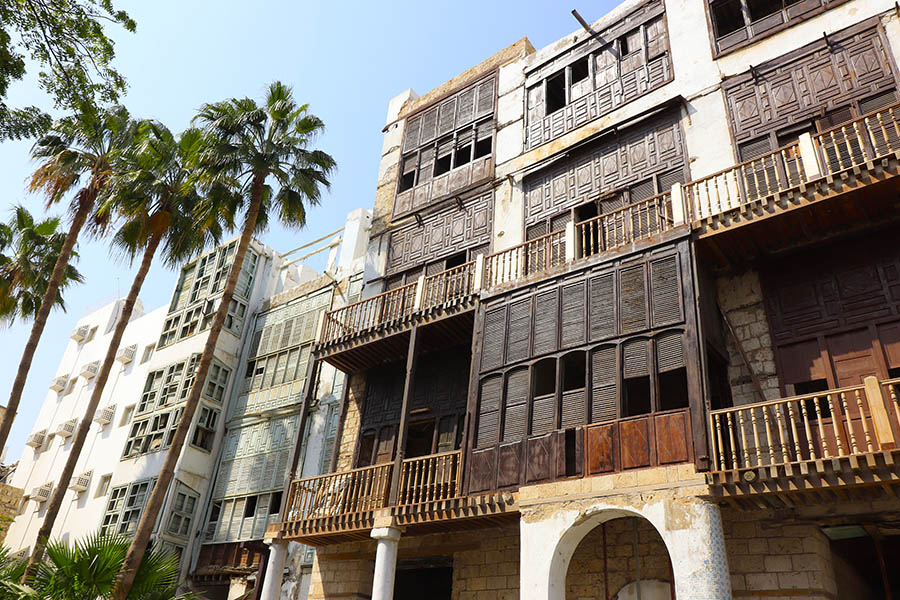
The second stage of the trip focused on Jeddah, a coastal city in the west of the Saudi Kingdom and the anchorage point for numerous pilgrims to Mecca (and today for countless cruise ship tourists). Second only to Riyadh in size and importance, Jeddah today is the result of hasty growth and somewhat chaotic urban planning. However, it hides gems such as the old city, called Al-Balad, once fortified, which displays wonderful Ottoman-era architecture with its large balconies covered with wooden latticework. This partially restored old town is surviving thanks to mass tourism, with its cobbled alleys and beautiful old houses converted into ethnographic museums, cafés, and galleries.
The second stage of the trip focused on Jeddah, a coastal city in the west of the Saudi Kingdom and the anchorage point for numerous pilgrims to Mecca (and today for countless cruise ship tourists).
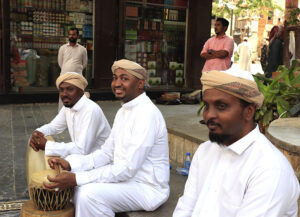
In addition to strolling through Al-Balad and the pleasant Corniche (maritime promenade), the delegation had the opportunity to attend the Islamic Art Biennale, organised by the Diriyah Biennale Foundation, a foundation created in 2020 under the auspices of the Saudi Ministry of Culture; along with Ithra, another of the highlights of the refreshing cultural opening that the country is experiencing. Inaugurated at the beginning of 2023, this first biennial will include all the Muslim communities scattered around the world through all kinds of contemporary expressions and historical pieces of extreme value. Once again, the narrative here is perfectly coherent through clever scenography and curatorship. Ithra has collaborated in this major event through the Hegira-themed exhibition ‘A Journey of Understanding’, with a series of pieces, including a Chinese Qur’an, and a kiswa, or outer curtain of the Kaaba.
A biennial of Islamic art and a documentary film
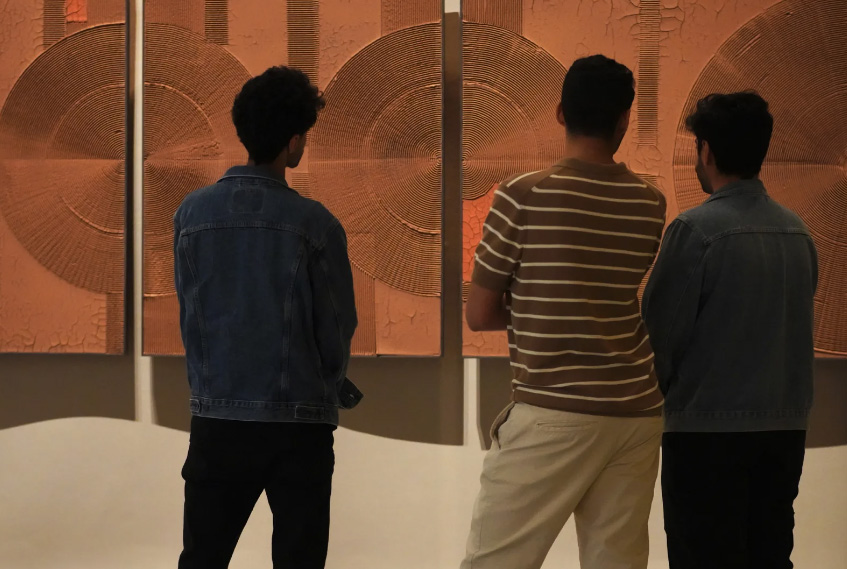
The biennial, which runs until 23 April and is accompanied by various activities during the month of Ramadan, has been organised in the fairgrounds next to the West Pilgrims Terminal, a major project awarded by the Aga Khan Foundation. Under the artistic direction of the South African architect Sumayya Vally, the exhibition begins with a very powerful sensorial immersion, through a succession of installations that, taking advantage of the enormous spaces of the site, manage to impress the visitor.
Entering the white cube of the Kaaba in Mecca, or the cemetery of the Prophet’s family, or vibrating under hundreds of simultaneous adhan (calls to prayer) or the frequency that the mind reaches during prayer, are some of the most piercing sensations. The meaning of collective and individual prayer, udhu (ablution), the equality of humans before the Divine, and the transcendence of death are some of the themes addressed by a myriad of Muslim artists from different latitudes.
Entering the white cube of the Kaaba in Mecca, or the cemetery of the Prophet’s family, or vibrating under hundreds of simultaneous adhan (calls to prayer) or the frequency that the mind reaches during prayer, are some of the most piercing sensations.
The second part of the biennial shows some of the best pieces of Islamic art in the world, including the Al Sabah collection from Kuwait, from Iranian ceramics with kufic epigraphy from the 10th century to Abbasid and Andalusian Qur’ans, blue Qur’an sheets from Qairouan, a spectacular Fatimid chess set made of rock crystal, metal and Mamluk glass, and many other objects.

Finally, the stay in Saudi Arabia ended with the premiere of the documentary In the Footsteps of the Prophet as a natural extension of the exhibition under the same theme organised by Ithra. The documentary was conceived and produced by the American filmmaker Ovidio Salazar, a specialist in Islamic history and civilisation to whom we owe documentary films on Al-Ghazali, Ibn Battuta, and the Moroccan philosopher Taha Abdurrahman.
‘In the Footsteps of the Prophet’ is based on the research of Dr. Abdallah Alkali, whose figure acts as the guiding thread, and is a slow, meditative, and profound film.
In the Footsteps of the Prophet is based on the research of Dr. Abdallah Alkali, whose figure acts as the guiding thread, and is a slow, meditative, and profound film into which the viewer enters little by little, step by step. The sobriety of the images and the luminosity of the landscapes, the use of the “one makes the path by walking”, the beautiful spiritual metaphors contained in the Koran about trust in God, the spiritual elevation symbolized by the mountains and the allusions to the condition of exiles over the centuries, create an atmosphere of tension and emotion that keeps the viewer – especially the Muslim viewer – glued to their seat and breathless until the end.


